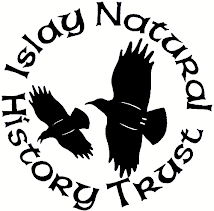What's happening
on Islay peatlands just now?
INHT has started
its rounds on the breeding bird surveys, we have been contracted to undertake
of the SAC sites adopted by ACT/CANN (Argyll countryside Trust &
Collaborative Action for Natura Networks).
This gives me a great opportunity to escape the computer and emails and
get out and see what stage nature is at in the season.
It also provides an opportunity to inspire people to start exploring Islay and Jura peatlands and engage with our Community Peatlands Project either through picking up a copy of our Peatland Passport or get you cameras and pencils out and capture what peatland means to you for our photo and poetry competition.
 |
Cast Northern Eggar moth cocoon
|
Our migrant birds
may have only just started piling in, however our resident breeders have been busy since the end of March. On the bogs, waders are on territory around
peatland pools, Redshank, Lapwing and a few Dunlin. I saw the first newly hatched duckling chicks
of Mallard. A joy not to be missed is
the bubbling, fluty notes of the Skylark ascending skywards into the blue
expanse above.
 |
| Bleached hummock of Sphagnum capilifolium |
I like to keep
note of the state of the flora, a much better marker for the season. Despite a very sunny month, it has been
tinged with cool, even chilly winds for the most part. Most significantly for our bog/peatland
habitats no rain! Peatlands thrive on
high air moisture and high rainfall to keep the peat wet, and overcast
conditions to prevent too much evaporation, which is something we cannot claim
for this past month.
 |
| Sphagnum cuspidatum in the edge of a dubh loch |
This was sadly
evident walking the bog this week, each footstep heard with a rustle and a
crunch of dry parched vegetation.
Where
the Sphagnums should have been soft and full of colour they are bleached from
the sun and form a dry crust, particularly on the hummock forms that cannot
draw moisture up so easily from deeper layers of peat. The small sphagnum pools
which should have been under water were empty with a slight moist layer of
Sphagnum cuspidatum, those in the edges
of the dubh lochs moist and plump.
As a
walker there were
no dilemmas about which was the driest route or how to get
over the wide soft squelchy bits without water going over my wellies!
 The drop in water
levels was evident in the larger lochan pools with bare peat showing at the
edges and deep overhangs which could make getting out difficult if you did not
have wings. I found one edge with many
scrape marks made with 5 toed claws, obviously the sign of use by an otter.
The drop in water
levels was evident in the larger lochan pools with bare peat showing at the
edges and deep overhangs which could make getting out difficult if you did not
have wings. I found one edge with many
scrape marks made with 5 toed claws, obviously the sign of use by an otter.


Amongst the dubh
lochs however, the state of permanent wetness provides a buffer to the drying
wind and sun. The first of the bog bean
is coming into bloom, such a pretty, lacy flower projecting from the dark
pools. This will be in flower for most
of May. Apart from this the only other
flowers requiring the services of the large Buff-tailed Bumblebees at present
were the isolated clumps of willow and a few Common Milkwort.

 |
Bog Bean
|
 |
Male flowers of Willow (a dioecious plant, the male and female flowers are on separate plants)
|
 |
| Hare's-tail Cotton Grass |
You can tell that
the main form of pollination for these early flowers is by wind. Hare's-tail Cotton Grass had already had its
pollination period as all the single seed head stems were developing their
fluffy white cotton tails. Common Cotton
Grass however was only just coming into 'flower', they differ in that multiple heads develop from the single stem, their yellow anthers dusted
with pollen dangling ready for the wind to lift it and carry it in hope of
being deposited on the stigma of another cotton grass head (what are the odds?....
quite slim, which is why vast amounts of pollen are produced by wind pollinated
plants). Also reliant on the wind are
the Deer Grass (not actually a 'grass') |
Common Cotton Grass head
with dangling male anthers |
it too was baring is pollen on its stiff bristly stems. The cones of Bog Myrtle also need the wind,
the deeply aromatic leaves net to sprout. |
Common Cotton Grass
(female stigma at top of head) |
 |
| Deer Grass (actually a sedge) |
 |
| Cones of Bog Myrtle |
 |
| Feur Lochain pools |
The sunny day
provided a stunning backdrop to a working walk, counting birds. I watched the dark clouds skirt round the
eastern hills, I assume depositing a light shower over the area of Port Ellen
and the Oa. |
| Bog bean stems stretching out of the pools |
Peatland Passport
Get out and
explore for yourselves, pick up your Peat Passport at the Blue Letterbox (Port
Ellen); Bowmore Post Office; Museum of Islay Life (Port Charlotte); Jura
Community Shop. Tick off the animals and
plants that you see and get your pages stamped.
There is much useful information and a quick and easy guide to what to
see on the moss. 
The Islay Nature Centre will be open mid May with more information on peatlands and other nature treasures on our islands.




































This comment has been removed by the author.
ReplyDeletehermes bag
ReplyDeletepg shoes
hermes sale online
jordan outlet
supreme hoodie
golden goose
off white
kobe
jordan outlet
bape
Hi nice reading your postt
ReplyDeleteIt's wonderful that you get to experience nature firsthand during these surveys.
ReplyDelete